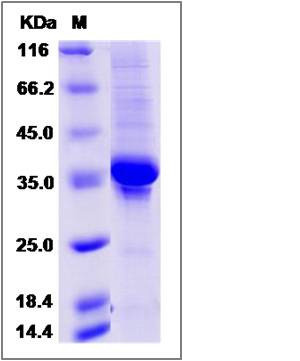Human PLAC9 / Placenta-specific 9 Protein (Fc Tag)
PLAC9
- 100ug (NPP2412) Please inquiry
| Catalog Number | P13971-H05H |
|---|---|
| Organism Species | Human |
| Host | Human Cells |
| Synonyms | PLAC9 |
| Molecular Weight | The recombinant human PLAC9/Fc is a disulfide-linked homodimer. The reduced monomer comprises 309 amino acids and has a predicted molecular mass of 34.5 kDa. The apparent molecular mass of the protein is approximately 37 in SDS-PAGE under reducing conditions. |
| predicted N | Ala 23 |
| SDS-PAGE |  |
| Purity | > 90 % as determined by SDS-PAGE |
| Protein Construction | A DNA sequence encoding the huamn PLAC9 (Q5JTB6) (Met1-Phe97) was fused with Fc region of mouse IgG at the C-terminus. |
| Bio-activity | |
| Research Area | |
| Formulation | Lyophilized from sterile PBS, pH 7.4. 1. Normally 5 % - 8 % trehalose and mannitol are added as protectants before lyophilization. Specific concentrations are included in the hardcopy of COA. |
| Background | PLAC9 belongs to the PLAC9 family. PLAC9 gene is a placental-enriched gene. There are other two placental-enriched genes: Plac1 and Plac8. Plac1 is strongly expressed in all trophoblast-derived cells in the placenta and has been described in 2000. Plac8 expression is restricted to the spongiotrophoblast layer during development, whereas PLAC9 is weakly expressed though highly enriched in placenta. For both, cDNAs with complete open reading frames were recovered and exon-intron structures inferred from comparisons of mouse cDNA and genomic sequence. The predicted proteins both contain putative signal peptides, with a coiled-coil segment of mPLAC9 as the only other detected motif. Genomic sequence comparisons reveal that in addition to an apparent pseudogene on chromosome 1, Plac8 is expressed at mouse cytoband 5e3. |
| Reference |
